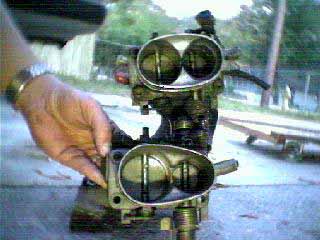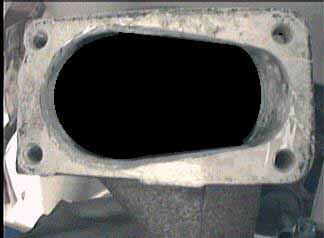| The next item up for replacement
is the throttle body.
Oversize throttle bodies are available from Neuspeed as well as other mail order speed shops and are nothing more than stock throttle bodies with adapter plates. Being that the throttle bodies are stock, they are certainly widely available from any junkyard. Yes, $15-$20 at the junkyard can get you the same throttle body than the one you get mail order for ten times as much. Be sure you pull your unit off of an Audi. The A2 ones are larger, but have the throttle linkage is on the wrong side of the throttle, unless you can find a Cabriolet in the junkyard. You can probably modify the A2 throttle to work, but with the abundance of Audis in the junkyards what''s the point? In the below picture I'm holding up a stock Audi throttle body, with an obviously larger primary butterfly, just below a typical A1 throttle body, still on the manifold. THAT SUCKER'S COMING OFF!
The throttle to look for doesn't require much contemplation. With the throttle inlet facing right (the way it would on your car), the linkage will be on top, and pulling the linkage toward you will open the throttles. Linkages not the same? Don't sweat it. Linkages are interchangeable as well. Here's the catch (Damn! There's a catch?): Although the throttle will bolt right up to the A1 manifold using a $3 A2 throttle body gasket from the dealer, you will find that the hole in the intake for the air inlet, is not as large as the hole required by the throttle! No sweat. If you have a Dremel or a Die Grinder, you're in business. I went to the junkyard and grabbed an extra intake manifold for $15 so I can grind at my leisure. You can choose to create one of two effects whilst grinding your intake. One emulates the effect given by the Neuspeed adapter plate that comes with their throttle body. The inlet of the adapter plate is the same, larger size of the throttle, and tapers down to the size of the A1 manifold on the other side. This gives you 0 hp gain, BUT awesome "throttle response", due to the fact that more air will be allowed into the intake with less depression of the gas pedal. Another way is to grind the inlet of the intake manifold all of the way open to the size of the new throttle body. Your choice. Using the gasket you just bought from the dealer as a template, color the inlet of the intake manifold with a magic marker. Note the small side of the throttle requires virtually NO grinding while the large butterfly side will require a GREAT DEAL of grinding. Once you have marked your inlet, SLOWLY start to cut along the outside edge of your new opening. Doing this at a low speed decreases your margin of error which is good, because you do NOT want your new larger hole to exceed the gasket's inner diameter. If you screw up now, you have minimal labor in the job so it does not hurt so much to go to the yard and get another manifold. Hey, you can always use this one as a core! I don't mean to scare you, but patience is a virtue in this job. Chances are you WON'T screw up and chances are you'll be so happy with your finished product that you'll run out and tell all of your buddies! Once you've done an outline cut of the new hole, put the cutter on your die grinder, Dremel or Wizard and start cutting from the inside out. I try not to get to close to my outline cut, as to avoid over enlarging my inlet. A few MM before the outline cut, I switch to a light duty grinder or heavy duty sander and scuff out the rest of the inner diameter. Blow the shavings out, rinse and dry and you're ready to go! You can see in the job I did below, I opted for a go between of the tapered mouth and the full sized mouth. Reason? Throttle response is not something I feel I need, and although any horsepower gain is minimal, this mod is sooooo cheap, why not do a tad more? I didn't want to make the opening too large because the wall on the backside of the manifold gets pretty thin. I kept about an 8MM thickness at the back of the manifold. I did opt to take the "factory lip" off of the small butterfly side of the intake's inlet for the hell of it. You can see the shininess along the ID of the intake where the grinding took place.
Actually getting the intake manifold on and off of the car is not covered in any manual. Usually you will read "remove manifold" when you have a procedure that requires removing the manifold. This is because the procedure is quite simple. There is only an air regulator, cold start valve and a throttle bolted to this thing. The intake is bolted to the head with six hex bolts and one thin metal "strap" that connects the intake two the exhaust. For those who need cut and dry instructions, here you go: You disconnect the throttle
cable by pulling the clip off of the cable end and pull the rubber boot
off of the intake by unscrewing the hoseclamp wrapped around it. You undo
the stupid metal bracket that connects the intake and exhaust in the center
of the manifolds (it's a 13MM). Disconnect the auxiliary air hose (in back)
and cold start injector activator. Unscrew all six 6MM hex bolts that hold
the intake to the head. It's off. If the hex bolts cooperate, the whole
job takes 15 minutes off and 25 minutes on.
|

